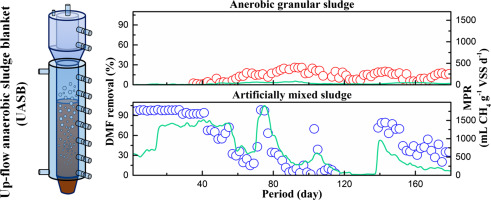Science of the Total Environment ( IF 9.8 ) Pub Date : 2018-08-21 , DOI: 10.1016/j.scitotenv.2018.08.161 Zhe Kong , Lu Li , Yu-You Li

|
Wastewater containing N, N-dimethylformamide (DMF) was treated by artificially mixing the anaerobic granular sludge (AGS) with DMF-degrading activated sludge (DAS) in this study. An up-flow anaerobic sludge blanket (UASB) successfully treated wastewater containing approximately 2000 mg L−1 DMF during an operation period of 215 days. An inoculation of DAS brought about remarkable results: a rapid start-up with effective DMF methanogenic degradation on the first day, and under a low organic loading rate (OLR) of 1.63–4.22 g COD L−1 day−1, the UASB maintained excellent DMF removal efficiency at over 96% along with the high methane production rate (MPR). However, when the OLR increased to 9.24 g COD L−1 day−1, DMF removal efficiency and MPR dropped to 47.36% and 1.05 L L−1 day−1. A further increase in the OLR to 13.25 g COD L−1 day−1 resulted in a sharp deterioration in the DMF-degrading ability, at merely 19.19% and a low MPR of 0.38 L L−1 day−1. The excessive elevation of OLR resulted in the insufficient hydrolysis of the DMF, and the further weakening of the conversion from DMF to intermediates and an acceleration the decaying of DMF-hydrolyzing bacteria. Methane-producing archaea was starved of intermediates when hydrolysis was inadequate. Since the DAS can be massively domesticated, and the OLR should be kept lower than 6.17 g COD L−1 day−1, the timely replenishing of the DAS to the UASB may be a solution to maintain a stable and effective DMF hydrolysis for long-term operation. The results of this study provide insight for the development of a new concept and an improved method for the effective treatment of wastewater containing degradation-resistant organics.
中文翻译:

UASB通过接种混合污泥快速启动处理含N,N-二甲基甲酰胺的废水的长期性能
在本研究中,将厌氧颗粒污泥(AGS)与DMF降解活性污泥(DAS)人工混合处理了含N,N-二甲基甲酰胺(DMF)的废水。上流式厌氧污泥层(UASB)在215天的运行时间内成功处理了含约2000 mg L -1 DMF的废水。带来显着的成效DAS的接种:一个快速启动与在第一天有效DMF甲烷降解和低有机负荷率下的1.63-4.22克COD L(OLR)-1 天- 1,UASB保持了出色的DMF去除效率(超过96%)以及高甲烷生成率(MPR)。然而,当OLR增加到9.24克COD大号-1 天- 1,DMF去除效率和MPR降至47.36%和1.05 L L -1 天- 1。进一步增加在OLR到13.25克COD大号-1 天- 1导致在DMF-降解能力急剧恶化,在仅仅19.19%和0.38 L L低MPR -1 天- 1。OLR的过度升高导致DMF的水解不足,并进一步削弱了从DMF到中间体的转化,并加速了DMF水解细菌的腐烂。当水解不充分时,产甲烷的古细菌缺乏中间体。由于DAS可以大规模驯化和OLR应保持低于6.17克COD大号-1 天- 1时,DAS到UASB及时补充可以维持长期稳定的和有效的DMF水解的溶液定期操作。这项研究的结果为有效处理含有抗降解有机物的废水的新概念和改进方法的发展提供了见识。



























 京公网安备 11010802027423号
京公网安备 11010802027423号